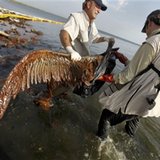
© AP Photo/Paul SancyaBethany Millhime looks for personal belongings in the aftermath of tornado damage in Millbury, Ohio Sunday, June 6, 2010.
Millbury, Ohio - Tornadoes and thunderstorms swept through the Midwest overnight, destroying dozens of homes and upending school buses and police cars in one miles-long trail of destruction in Ohio, and ripping off siding on a nuclear plant in Michigan. At least five people died in Ohio, including a child, authorities said.
Rescue officials in northwest Ohio were still searching through homes Sunday and couldn't say whether anyone else was missing, Lake Township Fire Chief Todd Walters said. Police Chief Mark Hummer flew over the damaged area and said at least 50 homes were destroyed and another 50 severely damaged, as well as six commercial buildings. He estimated a 7-mile path of destruction about 100 yards wide. The storm that hit around 11 p.m. Saturday fell over an area of farm fields and light industry, narrowly missing the heavily populated suburbs on the southern edge of Toledo.
"It's a war zone," Hummer said. "It's pretty disheartening."
Hummer said that among those killed were a person outside the police department and a motorist. He said a young child and two other victims were from nearby Millbury, a bedroom community of roughly 1,200 about 10 miles southeast of Toledo. The National Weather Service had confirmed Sunday afternoon that a Toledo-area tornado was part of the storm, said Meteorologist Marty Mullen of the service's Cleveland office.
Click
here to see tornado damage photos.



